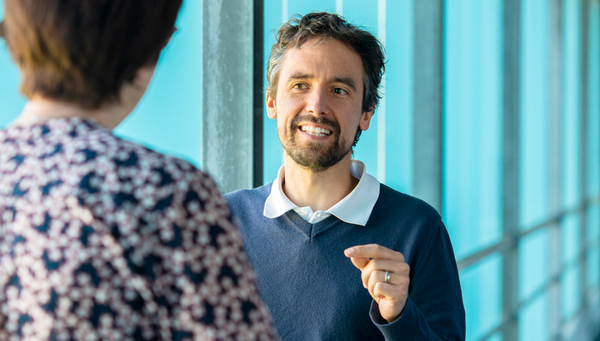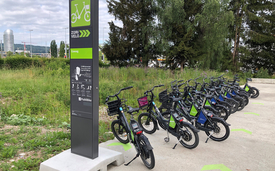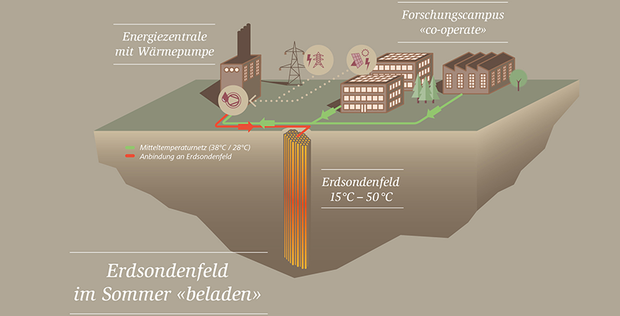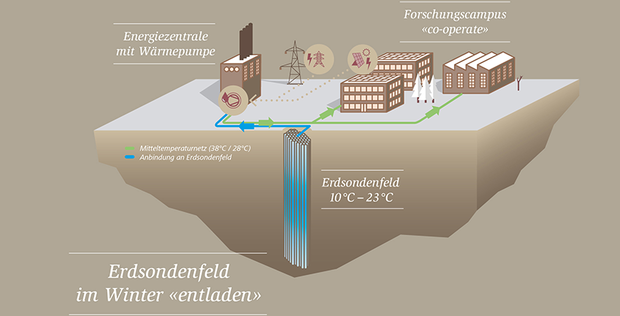Archive detail
Step by step to net zero
June 2, 2022 |
You took over the function as Eawag’s Environmental representative at the beginning of 2021 – in the middle of the coronavirus pandemic. As arduous as the enforced standstill has been for all of us, the environment has benefited. For example, hardly anyone flew, which can also be seen very clearly from Eawag’s statistics. In your opinion, will travel at Eawag soon return to the old level or has there been a change in thinking here?
Dominik Scheibler: I am very curious to see how this year will develop. A large proportion of the flights by our employees are undertaken to carry out work in the field. At Eawag, this accounts for about a quarter of the greenhouse gas emissions from flight activities and will certainly reach this level again, because you have to be on site for field work.
The situation is different for conferences – the second big item in official travel. I think these could be reduced by half and replaced by video conferences.
Eawag is already exemplary with its fly-aware policy. It states that for distances less than 1,000 km, trains should be used instead of planes wherever possible. Is this also put into practice?
Yes, in 2021, for example, there were only 10 flights with distances of less than 1,000 km. Four of them went to Greenland, where it is difficult to travel by train. And a few of them were domestic flights within Indonesia. There too, it is difficult to take the train.
“With the new Limnion building, the entire energy supply for the Kastanienbaum site will be 100% renewable.”
Are the CO2 emissions offset of flights that cannot be avoided?
Depending on the ticket price, a levy of between CHF 20 and CHF 200 is charged which Eawag uses to encourage people to switch to public transport and cycling. This was used, for instance, to finance the PubliBike station in Dübendorf or the bicycle parking hall at Stettbach train station. And thanks to this levy, Eawag can also offer its employees discounted season tickets for public transport.
The new PubliBike station at Eawag Dübendorf is one of the projects to promote cycling that were financed form the levy on airline tickets.
(Photo: Claudia Carle, Eawag)
In addition to mobility, the most renewable possible supply of electricity and heat to buildings is an important area of action if greenhouse gas emissions are to be reduced. Where does Eawag stand here?
Part of the electricity at both the Dübendorf and Kastanienbaum sites comes from the company’s own photovoltaic installations (around 5%). In addition, a co-generation unit in Dübendorf has been supplying part of the electricity since 2021 (around 6%). This electricity production is covered by naturemade star-certified biogas. For most of the rest of its requirements, Eawag purchases renewable green electricity, also with the naturemade star quality seal (95% of which comes from hydropower and 5% from photovoltaic).
Are there plans to expand the share of self-produced solar power?
Yes. In Kastanienbaum, there will be an additional photovoltaic installation on the planned new “Limnion” building. There is also potential for further installations in Dübendorf. The roof and façade of the new car park currently under construction on the Eawag-Empa campus will be covered with a photovoltaic installation. The roof of the children’s pavilion and possibly the façade of the Eawag laboratory building would also be suitable, but there are no concrete plans yet.
And what about the heat supply?
At the Kastanienbaum site, the heat supply has been almost entirely renewable for some time now. Heating is provided by a heat pump that draws environmental heat from Lake Lucerne. For emergencies – i.e. when it is particularly cold or the heat pump fails, as it did last winter, for example – there was still an oil heating system. This will be replaced by a wood pellet heating system as part of the new Limnion building, so that the entire energy supply for the Kastanienbaum site will then be 100% renewable.
And at the Dübendorf site?
Here we are using more and more waste heat and have invested quite a lot in recent years to further optimise the system. On the one hand, heat is recovered locally in the buildings from the exhaust air of the offices or from the central compressed air system. On the other hand, there is a district heating network on the Eawag and Empa campus, which all buildings are connected to. The waste heat from the refrigeration machines and freezers, for example, is fed into this network and can be used for heating by means of a heat pump. However, the waste heat cannot be stored at the moment. But that will change with the geothermal probe that is currently being built on the Empa site.
How will this geothermal probe work?
It will serve as seasonal storage. This means that the waste heat that is not needed in the summer can be stored in the ground via the probes and then used for heating in the winter. This will make it possible to use a much larger proportion of the waste heat in future. The rest of the heat demand will still be covered by gas heating, but this portion will then be significantly smaller. In 2021, 13% of the gas demand for building heating at Eawag was covered by certified biogas.
“With the geothermal probe currently under construction, it will be possible to use a much larger proportion of the waste heat in Dübendorf in the future.”
Since 2020, in accordance with federal requirements, all federal institutions, including Eawag, must be climate neutral in the building sector. This means that the CO2 emissions that we cannot avoid must be compensated. However, our objective is of course to avoid as many emissions as possible instead of just compensating for them and, for example, to be able to cover the entire remaining gas demand with biogas in future.
Are there other topics the environmental team is working on besides the central topic of energy/greenhouse gas emissions?
Yes, biodiversity is also an issue. The Eawag campus in Dübendorf is already doing very well in this respect, with many wildflower meadows, some alternating wetland sites near the aQa restaurant, the renaturalised Chriesbach stream and a naturalised area with hedges and small structures between the experimental ponds and the laboratory building. This creates a continuous green zone from the main road to the railway line. We would therefore like to have the entire Eawag site in Dübendorf certified by the Nature & Economy Foundation this year. This foundation promotes nature in urban areas and awards exemplary sites in this respect. When Empa’s new multi-storey car park is completed, many parking spaces on the campus can also be removed. These spaces will be used to create a new, near-natural green belt connecting Empa and Eawag.
The Eawag environmental team
Dominik Scheibler is managing director of crea Natura GmbH and has held a mandate as Eawag’s Environmental representative since February 2021. In this function, he is committed to the sustainable development of Eawag and also carries out corresponding performance reviews. Cooperation with the construction committee and Eawag’s technical service is also important. The exchange of views between those responsible for the environment throughout the ETH Domain is also intensive. For environmental concerns on the Eawag site, Dominik Scheibler is also supported by the Eco Team with representatives from various Eawag sectors. The Eco Team meets 4 to 6 times a year to plan the next measures. Suggestions from the employees are also taken into account. The Eco Team also organises events such as the clean-up day every autumn or work on greening the area.
Cover picture: Dominik Scheibler, Environmental representative at Eawag (photo: Peter Penicka, Eawag)




